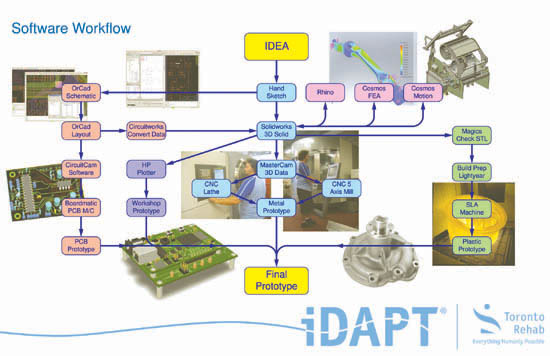
Physical rehab centre driven by design
Staff
General DPNMaintaining independence as we grow older is a desire shared by our families, our communities and ourselves.
Unfortunately, physical deterioration is inevitable and suddenly our homes, streets and public buildings reveal barriers to our mobility.
| LEFT: WATCH "FLY THROUGH" OF TORONTO REHAB’S IDAPT FACILITY
Working diligently to remove those barriers is a multidisciplinary team of scientists, engineers and industrial designers at the Toronto Rehabilitation Institute in downtown Toronto. Led by Geoff Fernie, vice president of Research at Toronto Rehab, the institute can take just about any researcher’s idea through design and build to proof-of-concept and commercialization. Advertisement
“Most of us know someone who is coping with the often daunting challenges of a disability caused by illness or injury. In fact, at some point, we will all experience a disability or care for someone who has one. |
“Rehabilitation research has the power to improve lives by providing practical solutions to everyday problems faced by people with disabilities and those encountering older age. Our technology team translates research into products,” said Fernie.
Rehab laboratory speeds design and commercialization of ideas
The institute’s Challenging Environment Assessment Laboratory (CEAL), consisting of a tightly integrated mechanical workshop, electronics development workshop and rapid prototyping workshop, ensures that product prototypes are delivered quickly into the hands of researchers.
CEAL is part of Toronto Rehab’s iDAPT (Intelligent Design for Adaptation, Participation and Technology) Facility set to open in February 2011. iDAPT is Toronto Rehab’s $36 million research initiative and part of a $146 million hospital capital redevelopment.
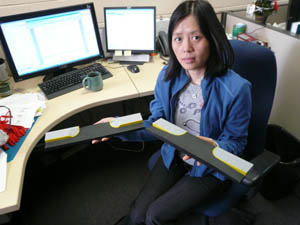 CEAL’s Research and Design Studio is where inventions are conceived and the designs are conceptualized. Researchers such as Yue Li (right; with sidewalk redesign to accommodate snow ploughing) and students from engineering, industrial design, clinical, architectural and other backgrounds collaborate in this workspace that emphasizes creative computer graphics and concept modelling with the help of a Stratasys Dimension uPrint 3D printer.
CEAL’s Research and Design Studio is where inventions are conceived and the designs are conceptualized. Researchers such as Yue Li (right; with sidewalk redesign to accommodate snow ploughing) and students from engineering, industrial design, clinical, architectural and other backgrounds collaborate in this workspace that emphasizes creative computer graphics and concept modelling with the help of a Stratasys Dimension uPrint 3D printer.
The studio has work equipped with SolidWorks mechanical CAD and Rhino surfacing design software, 2D printers/plotters, exhibit and modelling space, and an integrated team meeting space. Designs can also be analyzed with COSMOS FEA and Motion, as well as Magic Check STL for rapid prototyping build compliance.
ABS material prototypes of are manufactured in the workshop using a 3D Systems SLA 5000 stereolithography machine. This rapid prototyping capability equips scientists with the ability to quickly and accurately manufacture small quantities of products for validation testing and impact measurement in the living, working and learning environments.
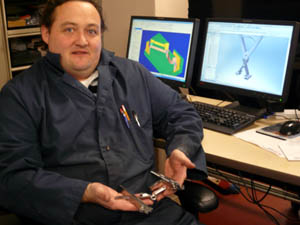 The CEAL Mechanical Workshop is equipped with the latest computer-controlled machine tools including ultra-high precision DMG Monoblock five-axis milling driven by MasterCAM software and run by Senior Machinist Colin Brackenridge (left). Other machine tools include a Colchester CNC Lathe with sub-spindle and live tooling, Milltronics CNC mill, Atlas manual mill, Colchester manual lathe and Kent 618 manual surface grinder, as well as a equipment for MIG, TIG, arc and spot welding.
The CEAL Mechanical Workshop is equipped with the latest computer-controlled machine tools including ultra-high precision DMG Monoblock five-axis milling driven by MasterCAM software and run by Senior Machinist Colin Brackenridge (left). Other machine tools include a Colchester CNC Lathe with sub-spindle and live tooling, Milltronics CNC mill, Atlas manual mill, Colchester manual lathe and Kent 618 manual surface grinder, as well as a equipment for MIG, TIG, arc and spot welding.
These tools are used to construct the instruments needed for research and the prototypes of the assistive device inventions. Anticipated products include new multidirectional powered wheelchairs with sophisticated seating and balancing systems, walking aids, fall prevention devices, communication aids and systems for transferring and repositioning patients.
The CEAL Electronics Workshop, led by Control Systems Specialist Alexander Levchenko (below) is equipped with a full range of instruments to support computer-aided design and automated fabrication of circuit boards. Included is Circuitworks, software that converts data for use in the SolidWorks platform, as well as OrCad Schematic and Layout programs, CircuitCam software and Boardmatic PCB M/C. Physical PCB prototypes are built with a suite of tools from LPKF such as ProtoMAT (PCB router), ProtoPlace (pick and place) and ProtoFlow (solder convection oven).
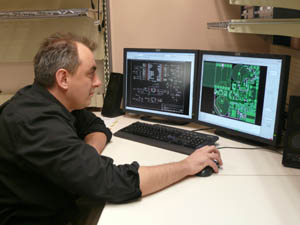 Once a circuit board is completed, a variety of debuggers and compilers are employed. These include IAR Embedded Workbench for ARM processors (IDE and compiler from IAR Systems), AVR Studio for AVR microcontrollers from Atmel, and MPLAB IDE and MPLAB C compilers for Microchip microcontrollers.
Once a circuit board is completed, a variety of debuggers and compilers are employed. These include IAR Embedded Workbench for ARM processors (IDE and compiler from IAR Systems), AVR Studio for AVR microcontrollers from Atmel, and MPLAB IDE and MPLAB C compilers for Microchip microcontrollers.
In the completed facility, room-sized pods can be adapted for a variety of research-driven projects. One pod will contain a real ice floor and snow, and can produce realistic wind.
Using a Bosch Rexroth hydraulic motion simulator, the ground surface can be tilted to create slopes or it can be moved suddenly to disturb balance. This provides a realistic, yet controlled environment to study human behavior and to test novel products.
By recreating these challenges, researchers will be able to develop practical solutions to obstacles encountered every day by older people and by those with disabilities.
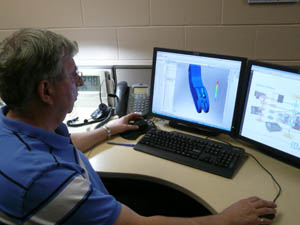 Dan Smyth, CAD Specialist, Research – iDAPT Technology R&D Team (left), demonstrates the SolidWorks design and simulation environment used in CEAL. The software platform is supported by Javelin Technologies of Oakville, ON.
Dan Smyth, CAD Specialist, Research – iDAPT Technology R&D Team (left), demonstrates the SolidWorks design and simulation environment used in CEAL. The software platform is supported by Javelin Technologies of Oakville, ON.
Since each “payload” will have on-board microprocessors monitoring a host of sensors, Quanser Inc. (www.quanser.com) of Markham, ON, has been commissioned to provide the computer systems for CEAL. Quanser has been active with Toronto Rehab on different projects that exploit its haptic control (sensory feedback) technologies.
An iDAPT Home Environment Laboratory will also feature a typical single-story dwelling to allows researchers to develop new tools to help people overcome the challenges they face in their own homes.
Fernie said that iDAPT is addressing two important issues that have been historical stumbling blocks. “Academics haven’t been able to commercialize their work,” and “researchers have bright ideas, but insufficient resources.” The Club, a group of industry partners and researchers at Toronto Rehab, was created to address those issues.
| Industrial designer Adam Sochak (right)demonstrates Toronto Rehab’s SlingSerter creation, a device for assisting in lifting patients comfortably. Click on the video for a demo of the SlingSerter in action.
Being in The Club gives industry partners the opportunity to negotiate a business arrangement if they see something they think they can sell.
Companies are included in the entire process of product development from the concept stage onwards, giving feedback in regular meetings and prototype development labs. “There’s a perception out there that it’s not easy to make money out of products and technologies for people with disabilities,” Fernie stated. “We want to make it easier for companies to get involved. |
|
”Toronto Rehab receives royalties from its industry Club partners for every product sold, and these funds are channelled back into research. But the most important goal is not to make money,” explained Fernie. “We want to see our research applied, helping people to lead better lives, at the same time creating jobs and wealth in our community.”
Below: The software workflow at iDAPT illustrates the lengths that Toronto Rehab has taken in order to provide a complete product concept turnkey operation.
